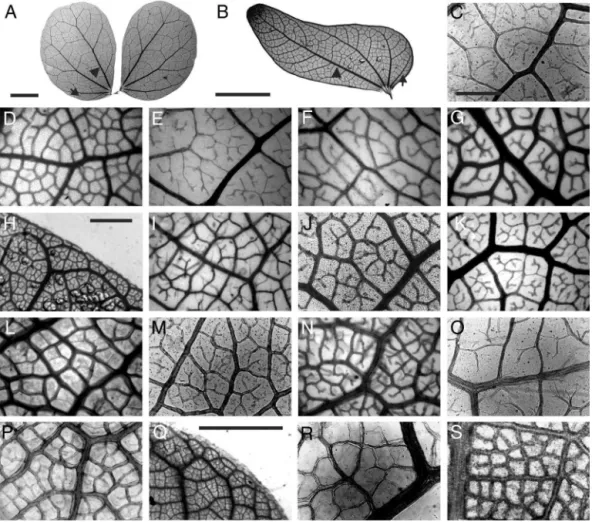RevistaBrasileiradeFarmacognosia27(2017)158–161
w ww.e l s e v i e r . c o m / l o c a t e / b j p
Original
Article
Leaf
venation
pattern
to
recognize
austral
South
American
medicinal
species
of
“cow’s
hoof”
(
Bauhinia
L.,
Fabaceae)
Renée
H.
Fortunato
a,
Beatriz
G.
Varela
b,
María
A.
Castro
c,
María
J.
Nores
d,∗aInstitutodeRecursosBiológicos(InstitutoNacionaldeTecnologíaAgropecuaria–ConsejoNacionaldeInvestigacionesCientíficasyTécnicas)andFacultaddeAgronomíayCiencias
Agroalimentarias,UniversidaddeMorón,BuenosAires,Argentina
bFacultaddeFarmaciayBioquímica,UniversidadNacionaldeBuenosAires,BuenosAires,Argentina cFacultaddeCienciasExactasyNaturales,UniversidadNacionaldeBuenosAires,BuenosAires,Argentina
dInstitutoMultidisciplinariodeBiologíaVegetal(UniversidadNacionaldeCórdoba–ConsejoNacionaldeInvestigacionesCientíficasyTécnicas)andFacultaddeCienciasExactas,
FísicasyNaturales,UniversidadNacionaldeCórdoba,Córdoba,Argentina
a
r
t
i
c
l
e
i
n
f
o
Articlehistory:
Received6September2016 Accepted28October2016 Availableonline8December2016
Keywords:
Areolation
Botanicalidentification Freelyendingveinlets Leafvenationpattern Qualitycontrol
Schnella
a
b
s
t
r
a
c
t
TheleavesextractsofsomespeciesofBauhiniaL.s.l.areconsumedtotreatdiabetes,inflammation, painsandseveraldisordersintraditionalmedicineinaustralSouthAmerica.Despiteitswideuseand commercialization,saleisnotcontrolled,andbotanicalqualityofsamplesisnotalwaysadequatebecause ofplantmisidentificationandadulteration.Here,wecharacterizedleafveinpatterninnineteentaxato contributetotherecognitionandcommercialqualitycontrolofplantmaterialcommerciallyavailable. Theveincharactersintercostaltertiaryandquinternaryveinfabric,areoledevelopmentandshape,free endingveinletbranchingandmarginalultimatevenationallowedtodistinguishthemainmedicinal speciesintheregion.
©2016SociedadeBrasileiradeFarmacognosia.PublishedbyElsevierEditoraLtda.Thisisanopen accessarticleundertheCCBY-NC-NDlicense(http://creativecommons.org/licenses/by-nc-nd/4.0/).
Introduction
TheleavesextractsofsomespeciesofBauhiniaL.,Fabaceae,so calledcow’shoof,“pata-de–vaca”,cow’spawororchidtrees,are consumedtotreatdiabetes,inflammation,painsandseveral dis-ordersintraditionalmedicineinaustralSouthAmerica(Oliveira and Saito, 1989; Bortoluzzi et al., 2006; Barboza et al., 2009; Pizzioloetal.,2011;Fortunato,2012).With300speciesworldwide,
Bauhinias.l.isrepresentedbyfifteenspeciesinArgentina,Paraguay, UruguayandSantaCatarina,ParanáandRioGrandedoSulstates ofBrazil(Fortunato,1986,1996;Fortunatoetal.,2008;Vazetal., 2010).
Bauhiniabauhinioides(Mart.)J.F.Macbr.,B.microstachya(Raddi) J.F.Macbr.,B.ungulataL.,B.holophylla(Bong.)Steud.,B.forficata
Link, B.cheilantha (Bong.)Steud. and B. rufa (Bong.) Steud.are themainspeciesforwhichpharmacologicalactivitieshavebeen reported.Hypoglycemic,antioxidant,analgesic,antiinflammatory andlarvicidalactivitiesalongwithantitumorpotentialityletthem auspicioustargetsfornewbioactivesubstancesresearchingand phytotherapy(SilvaandCechinelFilho,2002;Sousaetal.,2004;
∗ Correspondingauthor.
E-mail:jnores@imbiv.unc.edu.ar(M.J.Nores).
Gadottietal.,2005;Lunaetal.,2005;Nakahataetal.,2006;Cechinel Filho,2009;Paulaetal.,2014;Rozzaetal.,2015;Martins-Olivera etal.,2016).
Thesetaxaareextensivelyemployedandsoldinnative Amer-ican,ruralandurbancommunitiesintheregionandsurrounding areas(Bortoluzzietal.,2006;Barbozaetal.,2009;Hurrelletal., 2011;IbarrolaandDegendeArrúa,2011).Despiteitswideuseand commercialization,saleisnotcontrolled,andbotanicalqualityof samplesisnotalwaysadequatebecauseofplantmisidentification andadulteration.Commercialsamples–crudeherbsor industrial-izedherbalmedicines–includeentireorbrokendriedleaves,stems andoftenpods.Ingeneral,plantsareharvestedfromtheirnatural habitats,beingpopularlyrecognizedbytheirbilobedorbifoliolate leaves.Speciesaredifficulttoidentify,especiallyfromvegetative stagesorinfragmentedmaterial,andsamplelabelingandtrading aremostlyaccomplishedbyusingcommonnames,genericname orincorrectnames(Meloetal.,2004).Theseoftenresultin adul-terated,falsifiedorsubstitutesamples,whichwouldinterferewith theeffectivenessandeventhesafetyoftheproduct(Ferreresetal., 2012).Leaf anatomicalfeatures areusefulforidentificationand adequatesamplebotanicalquality,inBauhinias.l.,venationpattern hasbeenutilizedintaxonomy,phylogeneticanalysesandevenin palaeobotany(Vaz,1979;Fortunato,1986;Zhang,1994;Linetal., 2015).
http://dx.doi.org/10.1016/j.bjp.2016.10.007
R.H.Fortunatoetal./RevistaBrasileiradeFarmacognosia27(2017)158–161 159
Fig.1.LeafvenationinsouthernSouthAmericanBauhinia.(AandB)Generalveinpattern.(C–G,I–P,RandS)Areolation.(HandQ)Loopedmarginalultimatevenation.(A)B. bauhinioides.(B)B.hagenbeckii.(C)Bauhiniaaffinis.(D)B.angulosa.(E)B.argentinensis.(F)B.bauhinioides.(GandH)B.campestris.(I)B.cheilantha.(J)B.forficatassp.pruinosa. (K)B.hagenbeckii.(L)B.holophylla.(M)B.microstachya.(N)B.mollisvar.mollis.(O)B.mollisvar.notophila.(PandQ)B.rufa.(R)B.ungulatavar.ungulata.(S)B.uruguayensis. Arrowhead:basalveins.Arrow:agroaphicveins.Scalebar:AandB:3mm;C–G,I–P,RandS:300m;H,Q:1mm.
Inthis work,wecontributetotherecognitionand commer-cialqualitycontrolofaustralSouthAmericanmedicinalBauhinia
throughastudyofleafveinpattern.
Materialsandmethods
Weanalyzed19australSouthAmericantaxa(Appendix1).The studyofleafvenationpatternwascarriedoutfollowingEllisetal. (2009).For this,freshorherbariumleaveswerecleared accord-ingtoDizeo deStrittmatter (1973)and stainedinsafranin/80% ethanol.SamplesweremountedinDPX(AldrichChemical Com-pany,Gillingham,UK)andexaminedusingZeissStereoMicroscope aZeissAxiolablightmicroscope(CarlZeiss,Germany)witha trinoc-ularphototubeandacolordigitalimagingcamera.Somevenation datawereextractedfrompreviouswork(Fortunato,1986,1996).
Resultsanddiscussion
Alltaxa analyzedpresent basal actinodromous primary vein framework, withnonaked basal veins,3–5(7) basal veins per lobeorleafletandagrophicveinssimple (Fig.1A andB). Previ-ously,someofthese taxahave beendescribed asacrodromous (Fortunato, 1986, 1996) or campylodromous (Vaz, 1979), and recentlybothAmericanBauhinias.s.andSchnellaareconsidered actinodromous or acrodromous by Lin et al. (2015).Main vein characters(Fig.1,Table1)provideacriteriontoidentificationof medicinalspecies anddetectionoffalsificationsor adulteration.
Theareoledevelopmentallowsdifferentiatingthreemaingroups, someofthem,butnotall,taxonomicallyrelated.
Thefirstgroupischaracterizedbyagoodareoledevelopment that is foundin some medicinalmembers of sect.Pauletia ser. Cansenia,inthelianaBauhiniaangulosa(=S.angulosa)andinthe spinytreeB.uruguayensis(Fig.1D,L,P–S).ThemedicinalB. holo-phyllaandB.rufabothdisplayquadrangularandpentagonal,rarely triangularareoles,withabsentandunbranchedfreelyending vein-lets (FEV),the firstone canbe furtherrecognizedsince FEVin generalcrosstheareolaandmarginalultimatevenationand quin-ternaryveinfabricvenationareabsent(Fig.1L).B.rufa,instead, presentsloopedmarginalultimatevenationandquinternaryvein fabricpresent(Fig.1PandQ).ThemedicinalB.ungulatahasabsent, unbranchedandonebranchedFEVandareolashapemore vari-able(Fig.1R).Somesimilarfeatureshavebeendescribedinothers taxafromser.Cansenia,andZhang(1994)nameditasthe Canse-niavenationtype.B.angulosaiseasilydistinguishedbecauseofthe verysmallareoleslackingFEVandmarginalultimateveinabsent (Fig.1D).B.uruguayensisistheonlytaxonthatpresentspaxillate areoledevelopmentwithoutFEV,orjustveryfew FEV(Fig.1S), thesefeaturesaresimilartotheElayunatypedescribedbyZhang (1994).
160 R.H.Fortunatoetal./RevistaBrasileiradeFarmacognosia27(2017)158–161
Table1
LeafvenationpatterninaustralSouthAmericanBauhinia.FEV,freelyendingveinlets;P,pentagonal;PE,percurrent;Q,quadrangular;R,reticulate;T,triangular.
Species Intercostal tertiaryvein fabric Quinternary veinfabric Areole development
Freeendingveinlet (FEV)branching
Areoleshape Marginal ultimate venation
Fig.1
B.affinis PE Present Moderate Unbranchedandoneor twobranched;rarely absent
variable Absent C
B.amambayensis Ratapex,PEat base
Present Moderate Unbranchedandwith oneormorebranches; sometimesabsent
variable Absent
B.angulosa(=S. angulosa)
Ratapex,PEat base
Absent Good Absent;rarely
unbranched
QandP,rarelyT Absent D
B.argentinensis Ratapex,PEat base
Present Moderate Mostlywithoneor morebranches; sometimesunbranched
Variable Absent E
B.bauhinioides R Absent,topoor distinct
Moderateto good
Mostlyunbranched andonebranched; rarelytwobranchedor absent
Variable Absent A,F
B.campestris PEtoR Absent Moderate, rarelygood
Mostlywithoneor morebranches; sometimes unbranched;rarely absent
Variable Looped GandH
B.cheilantha PE Absent Goodto moderate
Absent,unbranched andonebranched; rarelytwobranched.
Variable Absent I
B.forficata PE,notablyat base
Present Moderate Mostlywithoneor morebranches; sometimesunbranched
Variable Absent J
B.hagenbeckii Ratapex,PEat base
Present Moderate Mostlywithoneand morebranches;rarely unbranched
Variable Absent B,K
B.holophylla PE Absent Good Absentand unbranched(FEVs mostlycrossing areoles);rarelyone branched
QandP,rarelyT Absent L
B.microstachya(=S. microstachya)
Ratapex,PEat base
Absent,topoor distinct
Moderate Mostlyunbranched andonebranched; sometimeswithmore branches
Variable Loopedand absent
M
B.mollisvar.mollis PEtoR Present Moderate Mostlyunbranched andonebranched; sometimeswithmore branchesorabsent
Variable Absent N
B.mollisvar.
notophila
PE Poordistinct Moderate Mostlyunbranched
andwithoneormore branches;rarelyabsent
Variable Absent O
B.rufa PE Present Good Absentand
unbranched
QandP,rarelyT Looped PandQ
B.ungulatavar.
cuiabensis
PEtoRatapex Absent Good Absent,unbranched andonebranched
VariabletoQ,P,T Loopedand absent
B.ungulatavar.
ungulata
PEtoRatapex Absent,topoor distinct
Good Absent,unbranched andonebranched
VariabletoQ,P,T Looped R
B.uruguayensis Ratapex,PEat base
Present Good/paxillate Absent;rarely unbranchedandone branched
QandP,rarelyT Loopedand inpart absent
S
group. The medicinal B. forficata (both subspecies), B. argenti-nensis and B. hagenbeckii show almost the same pattern, with mostlybranchingFEV(oneormorebranches)andlessfrequently, unbranchedFEV(Fig.1J,E,K).B.forficatacanbedistinguishedby thepercurrenttertiaryveinfabric,whiletheothersarepercurrent atthebaseand reticulateat apex.B. affinis(Fig.1C), B. amam-bayensis(notshown)andB.mollis(Fig.1N,O)haveingeneralboth unbranchedandbranchedFEV,indifferentfrequency.The medici-nallianaB.microstachya(=S.microstachya)possessesalsomoderate areoledevelopment,mostlyunbranchedandonebranchedFEV,but isrecognizedbecauseofthepresenceofbothloopedandabsent marginalultimatevenation(Fig.1M),thisreportissimilartothe onebyFortunato(1986)butdiffersfromprevious(Zhang,1994).
Finally, the medicinal B. cheilantha and B. campestris (sect.
Pauletiaser.Cansenia)presentareoledevelopmentintermediate between good and moderate. B. cheilantha alternates between absent,unbranchedandonebranchedFEVandultimatevenation absentwhileB.campestriscanbedistinguishedbecauseFEVare in generalbranchedandultimatevenation is looped(Fig.1I,G andH).ThemedicinalB.bauhinioides(sect.Pauletiaser.Perlebia) alsopossessareoledevelopmentmoderatetogoodbutareolesare mostlyunbranchedandonebranched(Fig.1F).
Interestingly,allspeciespresentprismaticcrystalsofcalcium oxalateassociatedtovascularbundlesandoftendrusesin meso-phyllcells,morenotableinB.affinis,B.argentinensis,B.mollisand
R.H.Fortunatoetal./RevistaBrasileiradeFarmacognosia27(2017)158–161 161
Hereweprovideahelpfultoolfortherecognitionofthemain regionalmedicinalplantsthroughtheanalysisoftheleafvein pat-ternbasedontheintercostaltertiaryandquinternaryveinfabric, areoledevelopmentandshape,freeendingveinletbranchingand marginalultimatevenationcharacters.
Authors’contributions
RHF collected and identified the plants, performed the lab-oratory work and data analysis and participated in the results discussionandthemanuscriptfinalwriting.MACparticipatedin thelaboratoryworkanddataanalysis.BGVhelped performthe analysiswithconstructivediscussions.MJNdraftedthemanuscript.
Conflictsofinterest
Theauthorsdeclarenoconflictsofinterest.
Acknowledgements
We thank Cristo S. for technical assistance. CONICET (PIP 112-201101-00250), INTA (PNHFA-1106094) and SECyT-UNC (32720160200161CB)areacknowledgedforfinancialsupport.
AppendixA. Supplementarydata
Supplementarydataassociatedwiththisarticlecanbefound,in theonlineversion,atdoi:10.1016/j.bjp.2016.10.007.
References
Barboza,G.E.,Cantero,J.J.,Nú ˜nez,C.,Pacciaroni,A.,Espinar,L.A.,2009. Medici-nalplants:ageneralreviewandaphytochemicalandethnopharmacological screeningofthenativeArgentineFlora.Kurtziana34,7–365.
Bortoluzzi,R.L.C.,Miotto,S.T.S.,Reis,A.,2006.Bauhinia.In:Reis,A.(org.),Flora IlustradaCatarinense,vol.2.HerbárioBarbosaRodrigues,Itajaí,pp.29–67. CechinelFilho,V.,2009.Chemicalcompositionandbiologicalpotentialofplants
fromthegenusBauhinia.Phytother.Res.23,1347–1354.
DizeodeStrittmatter,C.G.,1973.Nuevatécnicadediafanización.Bol.Soc.Argent. Bot.15,126–129.
Ellis,B.,Daily,D.C.,Hickey,L.J.,Johnson,K.R.,Mitchell,J.D.,Wilf,P.,Wing,S.L.,2009. ManualofLeafArchitecture.CornellUniversityPress,NewYork.
Ferreres,F.,Gil-Izquierdo,A.,Vinholes,J.,Silva,S.T.,Valentão,P.,Andrade,P.B.,2012. BauhiniaforficataLinkauthenticityusingflavonoidsprofile:relationwiththeir biologicalproperties.FoodChem.134,894–904.
Fortunato,R.H.,1986.RevisióndelgéneroBauhinia(Cercideae,Caesalpinioideae, Fabaceae).Darwiniana27,527–557.
Fortunato,R.H.,1996.Bauhiniaaffinis(Fabaceae)unanuevacitaparalaFlora Argentina.Darwiniana34,405–409.
Fortunato,R.H.,(Ph.D.thesis)2012.GéneroBauhinia(Caesalpinioideae, Legumi-nosae)enAustroamérica:caracterizacióntaxonómica,diferenciación morfológ-icayusospopulares.UniversidadNacionaldeBuenosAires,Buenos Aires, 238p.
Fortunato,R.H.,Miotto,S.,Izaguirre,P.,Beyhaut,R.,Bortoluzzi,R.L.C.,Ulibarri,E., Gómez-Sosa,E.,2008.Fabaceae.In:Zuloaga,F.O.,Morrone,O.,Belgrano,M.J.
(org.),CatálogodelasPlantasVascularesdelConoSur.Monog.Syst.Bot.107, 2078–2319.
Gadotti,V.M.,Santos,A.R.,Meyre-Silva,C.,Schmeling,L.O.,Machado,C.,Liz,F.H., 2005.Antinociceptiveactionoftheextractandtheflavonoidquercitrinisolated fromBauhiniamicrostachyaleaves.J.Pharm.Pharmacol.57,1345–1351. Hurrell,J.A.,Ulibarri,E.A.,Puentes,J.P.,BuetCostantino,F.,Arenas,P.M.,Pochettino,
M.L.,2011.Leguminosasmedicinalesyalimenticiasutilizadasenlaconurbación BuenosAires–LaPlata,Argentina.Bol.Latinoam.Caribe10,443–455. Ibarrola, D.A., Degen de Arrúa, R.L., 2011. Catálogo Ilustrado de 80 Plantas
MedicinalesdelParaguay.FacultaddeCienciasQuímicas–UNA,Agenciade CooperaciónInternationaldelJapón(JICA),Asunción.
Lin,Y.,Wong,W.O.,Shi,G.,Shen,S.,Li,Z.,2015.BilobateleavesofBauhinia (Legumi-nosae,Caesalpinioideae,Cercideae)fromthemiddleMioceneofFujianProvince, southeasternChinaandtheirbiogeographicimplications.BMCEvol.Biol.15, http://dx.doi.org/10.1186/s12862-015-0540-9.
Luna, J.D.S., Santos,A.F.,Lima,M.R.F., Omena,M.C., Mendonc¸a, F.A.C., Bieber, L.W.,Sant’Ana,A.E.G.,2005.Astudyofthelarvicidalandmolluscicidal activ-itiesofsomemedicinalplantsfromnortheastBrazil.J.Ethnopharmacol.97, 199–206.
Martins-Olivera, B.T.,Almeida-Reis, R., Theodoro-Júnior,O.A., Oliva, L.V., San-tos Nunes, N.N., Olivo, C.R., Brito, M.V., Prado, C.M., Leick, E.A., Arruda Martins, M., Oliva, M.L.V., Righetti,R.F., Tibério, I.F.L.C., 2016. The plant-derivedBauhiniabauhinioideskallikreinproteinaseinhibitor(rBbKI) attenu-ateselastase-inducedemphysemainmice.Mediat.Inflamm.,http://dx.doi. org/10.1155/2016/5346574.
Melo,J.G.,Nascimento,V.T.,Amorim,E.L.C.,AndradeLima,C.S.,Albuquerque,U.P., 2004.Avaliac¸ãodaqualidadedeamostrascomerciaisdeboldo(Peumusboldus Molina),pata-de-vaca(Bauhiniaspp.)eginco(GinkgobilobaL.).Rev.Bras. Far-macogn.14,111–120.
Oliveira,F.,Saito,M.L.,1989.Algunsvegetaisbrasileirosempregadosnotratamento dadiabetes.Rev.Bras.Farmacogn.2–4,170–196.
Nakahata,A.M.,Bueno,N.R.,Rocha,H.A.,Franco,C.R.,Chammas,R.,Nakaie,C.R., Jasiulionis,M.G.,Nader,H.B.,Santana,L.A.,Sampaio,M.U.,Oliva,M.L.V.,2006. Structuralandinhibitorypropertiesofaplantproteinaseinhibitorcontaining theRGDmotif.Int.J.Biol.Macromol.40,22–29.
Paula,C.D.S.,Canteli,V.C.D.,Hirota,B.C.K.,Campos,R.,Oliveira,V.B.D.,Kalegari,M., Silva,C.B.,Silva,G.M.,Miguel,O.G.,Miguel,M.D.,2014.Potencialantioxidante invitrodasfolhasdaBauhiniaungulataL.Rev.Cien.Farm.Bas.Apl.35,217–222. Pizziolo,V.R.,Brasileiro,B.G.,Oliveira,T.T.,Nagem,T.J.,2011.Plantascompossível atividadehipolipidêmica:umarevisãobibliográficadelibroseditadosnoBrasil entre1998e2008.Rev.Bras.Pl.Med.13,98–109.
Rozza,A.L.,Cesar,D.A.S.,Pieroni,L.G.,Saldanha,L.L.,Dokkedal,A.L.,De-Faria,F.M., Souza-Brito,A.R.M.,Vilegas,W.,Takahira,R.K.,Pellizzon,C.H.,2015. Antiulcero-genicactivityandtoxicityofBauhiniaholophyllahydroalcoholicextract. Evid.-BasedComplement.Alternat.Med.,http://dx.doi.org/10.1155/2015/439506. Silva,K.L.,CechinelFilho,V.,2002.PlantasdogêneroBauhinia:composic¸ãoquímica
epotencialfarmacológico.Quim.Nova25,449–454.
Sousa,E.,Zanatta,L.,Seifriz,I.,Creczynski-Pasa,T.B.,Pizzolatti,M.G., Szpogan-icz,B.,Silva,F.R.M.B.,2004.Hypoglycemiceffectandantioxidantpotentialof kaempferol-3,7-O-(␣)-dirhamnosidefromBauhiniaforficataleaves.J.Nat.Prod. 67,829–832.
Trethowan,L.,Clark,R.,Mackinder,B.,2015.Asynopsisoftheneotropicalgenus Schnella(Cercideae:Caesalpinioideae:Leguminosae)including12new combi-nations.Phytotaxa204,237–252.
Vaz,A.M.S.F.,1979.Considerac¸õessobreataxonomiadogêneroBauhiniaL.sect. TylotaeaVogel(Leguminosae–Caesalpinioideae)doBrasil.Rodriguésia31, 127–234.
Vaz,A.M.S.F.,Bortoluzzi,R.L.C.,Silva,L.A.E.,2010.ChecklistofBauhiniasensustricto (Caesalpiniaceae)inBrazil.PlantEcol.Evol.143,212–221.
Wunderlin,R.P.,2010a. Reorganizationofthe Cercideae(Fabaceae: Caesalpin-ioideae).Phytoneuron48,1–5.
Wunderlin,R.P.,2010b.NewcombinationsinSchnella(Fabaceae:Caesalpinioideae: Cercideae).Phytoneuron49,1–5.
